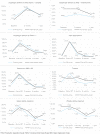Swallowing Exercise During Head and Neck Cancer Treatment: Results of a Randomized Trial
- PMID: 34117531
- PMCID: PMC9345844
- DOI: 10.1007/s00455-021-10320-5
Swallowing Exercise During Head and Neck Cancer Treatment: Results of a Randomized Trial
Abstract
The diagnosis and treatment of head and neck cancer (HNC) can have substantial impact on swallowing function, nutritional balance, physical function and quality of life (QoL). Early initiated swallowing exercises are hypothesized to improve swallowing function in HNC patients. The aim was to investigate the effects of swallowing exercises and progressive resistance training (PRT) during radiotherapy on swallowing function, physical function and QoL in patients with pharynx-, larynx-, oral cavity cancer or unknown primary compared to usual care. In a multi-centre RCT participants were assigned to (a) twice-weekly PRT and daily swallowing exercises throughout treatment or (b) usual care. Outcomes were measured at end of treatment and 2, 6 and 12 months after. Primary outcome was penetration aspiration score (PAS). Data were analysed on an "intention-to-treat" basis by GEE logistic regression model, linear mixed effects model and cox regression. Of 371 invited HNC patients, 240 (65%) enrolled. Five participants were excluded. At 12 months follow-up, 59 (25%) participants were lost. Analyses showed significant effect on mouth opening, QoL, depression and anxiety at 12 months when comparing intervention to non-active controls. The trial found no effect on swallowing safety in HNC undergoing radiotherapy, but several positive effects were found on secondary outcomes when comparing to non-active controls. The intervention period may have been too short, and the real difference between groups is too small. Nevertheless, the need to identify long-lasting intervention to slow down or avoid functional deteriorations is ever more crucial as the surviving HNC population is growing.
Keywords: Deglutition disorders; Exercise; Head and neck neoplasms; Rehabilitation.
© 2021. The Author(s).
Figures




References
-
- Bressan V, Stevanin S, Bianchi M, Aleo G, Bagnasco A, Sasso L. The effects of swallowing disorders, dysgeusia, oral mucositis and xerostomia on nutritional status, oral intake and weight loss in head and neck cancer patients: a systematic review. Cancer Treat Rev. 2016;45:105–119. doi: 10.1016/j.ctrv.2016.03.006. - DOI - PubMed
Publication types
MeSH terms
LinkOut - more resources
Full Text Sources
Medical

